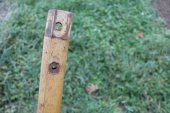
 1
1




 2
2




Argue for your limitations and they are yours forever.
 3
3




Gordon Haverland wrote:I'm reading a thread about someone who bought a scythe, and got injured.
All work on "the farm" is exercise. A new exercise takes time to adjust to. Time is something like 6 weeks in general.
There are 2 kinds of scythes: American (USA) and Austrian (European).
The American Scythes are much heavier than the Austrian scythes.
If the only things you will be cutting are grasses, you can get by with a very thin blade. If you "might" need to cut bigger things, get a thicker blade. If you might be cutting seedling trees, get a bushcutter blade.
Cutting with a scythe is like dancing well with a partner; it will take time to learn. Start with small areas and no pressure to get things done. The object is to learn the rhythm.
Cutting on significant slopes is different from cutting on "level" ground.
How hard you work in cutting anything with a scythe, depends on how sharp the edge is. If you think you are working too hard, it probably means your edge isn't sharp enough.
In a sense, scythes are like chisels. You really want them to be "scary sharp".
Learning how to make a blade in good shape "scary sharp" will take practice.
A blade that is not in good shape, needs to "peened". At some point all scythe blades need to be peened, to "expose" a new "edge" which "only" needs sharpeningl
---
There are competitions for using a scythe. It is unlikely that any of us will get close to what they can cut.
---
I have an interest in "hedge" (Osage-orange). It was apparently not uncommon for a farmer on the Great Plains to "prune" 750 feet of Osage-orange hedge in a day. And I will guess that is an American scythe.
With my poor ability with an Austrian scythe now, I don't know if I could deal with 750 feet of dandelion in a day. Let alone 750 feet of the hardest wood native to North America.
---
If people could add links to good examples on using and sharpening scythes; that would be wonderful.
(Of course, maybe they have; and I missed it.)
"To live at all is miracle enough" ~Mervyn Peake
Baryonyx Knife Co. --Owner








 2
2




Gordon Haverland wrote:Most of what I know about scythes (which is nowhere near enough) is specific to the Austrian style scythe that I bought (made in Vermont I believe).
The irons and steels used in agriculture, are seldom anywhere near the best they could be. My basic university degree is metallurgical engineering (but even then, I had options in ceramics). So, I nominally call it materials science and engineering because I also have a lot of wood, cement and organic chemistry added on top of things since.
I sort of grew up with farm equipment (not necessarily the farming), and I have done a little blacksmithing. But I have never attempted to forge a blade. I do understand why some steels are peened before sharpening. I never studied the steels in American scythes.
Off the top of my head, I would think a hadfield steel (high in manganese, high work-hardening) might work for blades like scythes, but they would probably rust away fast to. I haven't heard of any kind of scythe making use of a steel that had boron in it.
A Damascus steel would probably work wonderfully for a scythe, but the chemistry and labour of those steels is high.
But, thanks a lot for your comment. It probably will help a lot of people.
The two biggest hazards I seem to be putting my blade to, are seedlings that are too thick, and ant hills.
"To live at all is miracle enough" ~Mervyn Peake
Baryonyx Knife Co. --Owner

|
I met your mom on a Carribean cruise and she said you would help me and this tiny ad:
The new kickstarter is now live!
https://www.kickstarter.com/projects/paulwheaton/garden-cards
|







